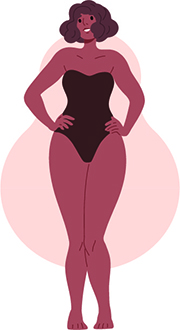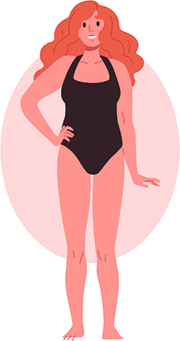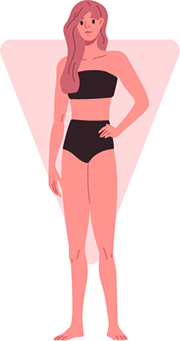International sewing patterns
International
sewing patterns
No language barrier · 9.500 patterns from 37 countries · incl. translation help
No language barrier · incl. translation help
9.500 patterns from 37 countries
Muslin fabric
90% PDF or Freebooks - immediately available
Categories
Filter selection
What is my body shape?

Pear
- Narrow shoulders
- Slim waist
- Strong hips/ thighs
- Round bottom

Rectangle
- Slim, straight stature
- Small bust
- Straight waist
- Small bottom

Round
- Large bust
- Pronounced body center
- Strong thighs
- Slim legs

Inverted triangle
- Broad shoulders
- Medium to large bust
- Rather straight waist
- Slim legs

Hourglass
- Narrow shoulders
- Slim waist
- Stong hips/ thighs
- Round bottom
Muslin fabric - light and comfortable
You might know muslins from burp cloths, baby diapers, or tablecloths. But the soft cotton fabrics with their crepe effect are much more versatile than they used to be and are now also very popular for clothing and accessories . For your next sewing projects using muslin, you'll learn a lot of useful information, tips and tricks here.
more see below...
What exactly is muslin?
Muslin fabrics are very soft and gentle fabrics made out of cotton or wool. The muslin fabric has a loose drape and is very suitable for clothing. Muslin is so soft because the threads are being twisted during production. Muslin is woven in the so-called plain weave and has a crinkle effect after washing.
Another word for the lightweight fabric is gauze or muslin gauze. There is also another type of muslin: the "Double Gauze," which is a double layer of muslin fabric. The two layers of Double Gauze are connected at various points throughout the fabric. Therefore, the fabric forms many small square pieces. This fabric is slightly thicker than a muslin fabric, which only has one layer. Furthermore, between the connections of both muslin fabrics small air spaces are formed, by which ‘Double Gauze’ is slightly puffed up and has a warming effect.
There's also muslin fabric with three layers of fabric. It is then called Triple Gauze and is even thicker and warmer. Muslin fabric is not only characterized by its great wearing comfort. It is also a very air-permeable and breathable fabric. Muslin is a woven fabric and therefore not elastic. Muslin fabrics do not need to be ironed. Of course, you can still iron the fabrics, but then you would also lose the creped effect. Muslin is a natural fabric without synthetic additives. In addition, muslin fabric is very absorbent and is thus ideally suited for its use as a baby diaper.
Muslin owes its name to its origin. The cotton fabric was discovered by Marco Polo in the Iraqi city of Mosul. There, muslin has been known since the 17th century and was mainly used for women's fashion. However muslin fabric is said to have originated from the Indian subcontinent in Bangladesh from the Dzaka region. From there, the fabric probably spread and gained popularity in the Arab and later Muslim areas.
In the 18th and 19th century, cotton muslin production experienced a real hype and was used for elegant women's dresses, especially in plain white. Women at that time did not want to wear anything else even in winter and consequently often caught a cold. Therefore, the name "muslin disease" came into popular use. In 1903, muslin fabric was even used for the first motorized airplane with a pilot. The inventors of the airplane (the Wright brothers) named "Wright Flyer", used muslin for covering the wings and the tail unit.
Nowadays, cotton muslin fabric is produced not only in the Orient, but the muslin industry is all over the world.
Double Gauze by the meter
Muslin fabric is available by the meter in muslin, double gauze and triple gauze. Since muslin fabric is woven from cotton, it can be easily dyed and printed but there's also unbleached muslin fabric with a natural look. The fabric is available in many great and beautiful colors. Of course, it can also be printed with patterns.
Use of muslin fabric
Due to the pleasant and soft feel of cotton muslin fabric, the skin-friendliness and airy properties, muslin is a great clothing fabric. In addition it is also quite durable.
As already mentioned, muslin, thanks to its high absorbency, is very popular for baby clothing and also diapers or burp cloths.
The fabric made of cotton is becoming more and more popular fro adult fashion as well. Due to its airy feeling, muslin fabric is especially suited for summer dresses, blouses or airy pants. Double gauze, can also be used for transitional seasons as the fabric is a bit thicker and warmer and still very soft. Soft scarves and shawls can also be sewn very well from double gauze. You could also line your muslin or double gauze with jersey to make your clothes suitable for winter.
Muslin is very versatile and can also be used for interior like a soft muslin blanket or pillow case.
Care tips
Washing
Muslin is mostly made of pure cotton so you can wash it at 30°C in the machine and with a normal spin cycle. Moisture causes the fabric to shrink a bit and enhances the creped and diamond-shaped look of the fabric. Therefore, the fabric will probably take on this structure a bit more after washing.
Drying
Although muslin fabric is relatively easy to care for, it is recommended to let the muslin air dry because otherwise you would risk it to shrink.
Ironing
The typical creped look of muslin makes ironing unnecessary. However, you can carefully iron the muslin fabric if it has shrunk too much during washing. If you iron muslin too much, you will lose the creped texture that is typical for the fabric.
Processing tips for muslin
Muslin is very easy to work with and is also great for sewing beginners. Due to the creped effect, the fabric even forgives an uneven seam.
Before processing, you should pre-wash your cotton muslin to make sure that your finished garment will fit perfectly. Otherwise, your finished garment may shrink during the first wash and become too small.
After that, you can cut your various pattern pieces with a sharp pair of suitable fabric scissors. To avoid having to copy the patterns on the uneven structure of muslin, you can transfer your pattern to the fabric with a copy wheel and cut directly along the pattern.
For sewing, it is best to choose a simple, straight stitch. With a very fine muslin fabric it is also helpful to use a fine needle (for example in size 70). Muslin is very suitable for sewing beginners, because it does not slip easily. You can make sure that the edges of the cotton fabric won't fray by using either with an overlock machine or a zigzag stitch.
Hopefully you enjoy your next sewing project with muslin.
Welcher Körper-Typ bist Du?

A-Typ - Birne
- Schultern schmal
- Taille schlank
- Hüften/ Oberschenkel kräftig
- Po rund

H-Typ - Banane
- Statur schlank, gerade
- Oberweite klein
- Taille gerade
- Po klein

O-Typ - Orange
- Oberweite groß
- Körpermitte ausgeprägt
- Hüften kräftig
- Beine schlank

V-Typ - Apfel
- Schultern breit
- Oberweite mittel bis groß
- Taille wenig ausgeprägt
- Beine schlank

X-Typ - Sanduhr
- Schulter + Hüfte ähnlich breit
- Oberweite groß
- Taille schlank
- Po rund



